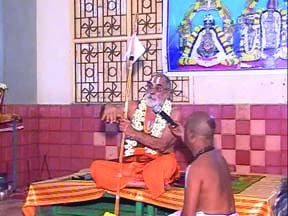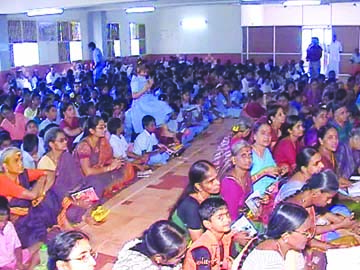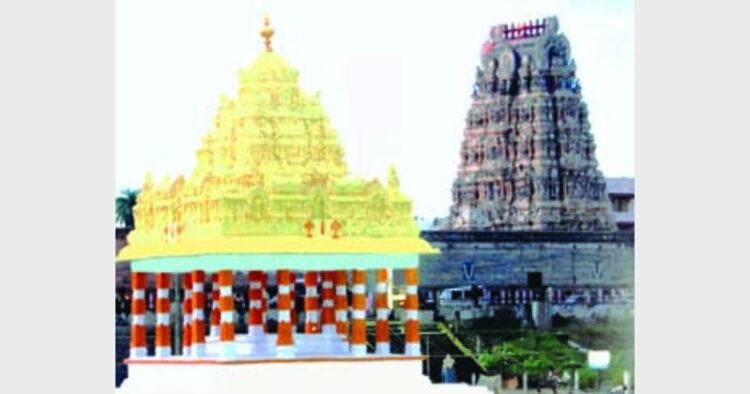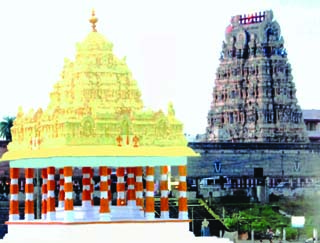The spiritual aim of Indian civilisation?
By V Shanmuganathan
Indian civilisation is not only a great cultural system, but is also an immense religious effort of the human spirit. These spiritual aspirations are the governing force of Hindu culture. The basis of Hinduism is the most dynamic for the inner spiritual life. The supreme divine God can be approached through a spiritual consciousness.
 This flame of Hinduism is preserved by the ordinary people through various religious practices like bhajans, chanting of mantras, recitation of shlokas and memorising of spiritual songs. During the winter, specially, Dhanur Month, a large number of devotees intensely carry on their religious practice with a spiritual outlook.
This flame of Hinduism is preserved by the ordinary people through various religious practices like bhajans, chanting of mantras, recitation of shlokas and memorising of spiritual songs. During the winter, specially, Dhanur Month, a large number of devotees intensely carry on their religious practice with a spiritual outlook.
Chanting of Vishnu Sahasranam
Many collective efforts are taking place without much advertisement or fanfare. Thiruvallur, is a town, 40 kilometres from Chennai. Sri Vaidhya Veeraragava Perumal Temple, one of the 108 Divya Desams (abode of Maha Vishnu), is majestically located in the centre of the town. One Shri AC Ravi, working in a public limited organisation, is leading a Bhakti Movement. Every year, he conducts Vishnu Sahasranam programme inside the premises of the Temple. This year he invited Sri Jeeyar Swamigal of Sriperumbuthur Mutt. He addressed the gathering of 5000 devotees. Students, youths, labourers, officegoers, both men and women, all of them recited Vishnu Sahasranamam collectively. Then Swamiji spoke about the importance of the recitation of the mantras, during winter season.
 Dhanur Masam has acquired unique significance of auspiciousness in Hindu spiritual calendar for devotional activities especially worshiping of Lord Maha Vishnu. More significance is attached for worshipping Lord Vishnu in Dhanur Masam during the early hours before sunrise known as Arunodayakala. In this month, one is expected to perform pooja during the auspicious Bramha Muhurta approximately two hours before the sunrise, when the stars are still twinkling in the sky. Swamiji said, “Vishnu Sahasranam is the essence of Mahabharata. The chanting of this strotram gives relief from all sorrows and leads to happiness and peace of mind.”
Dhanur Masam has acquired unique significance of auspiciousness in Hindu spiritual calendar for devotional activities especially worshiping of Lord Maha Vishnu. More significance is attached for worshipping Lord Vishnu in Dhanur Masam during the early hours before sunrise known as Arunodayakala. In this month, one is expected to perform pooja during the auspicious Bramha Muhurta approximately two hours before the sunrise, when the stars are still twinkling in the sky. Swamiji said, “Vishnu Sahasranam is the essence of Mahabharata. The chanting of this strotram gives relief from all sorrows and leads to happiness and peace of mind.”
Japa Sadhana
A single moment of honest and genuine deep thought of God is greater than the performance of many rituals. Though life appears to be very complicated, it would become joyful when we recite these shlokas and mantras understanding their meaning. It becomes Japa Sadhana. The more we practice, the greater will be the strength that we acquire. When we begin to recite everyday, we become stronger and stronger by profound thoughts of God and deeper contemplation on him. Because mantras are energy based sounds, subconscious mind of a staunch devotee can find a solution through meditation and recitation of mantras. A mantra, when repeated constantly during meditation, first loudly and then through silent and mental chanting, it changes our consciousness.
One Crore Recitation of Gayatri Mantra
Chanting of Veda Mantras, helps a person to face the difficult circumstances with courage and conviction. I remember an incident of barbarous attack on the head of a mass Hindu leader and how he regained the life after the deadly assault on him. About 30 years back, in the early 80s, after Meenakshipuram mass conversion, Sri Rama Gopalan, leader of Hindu Munnani, was speaking against fraudulent methods of conversion and smuggling of Hindu idols from temples. Next day, on the morning around 3 am, he was brutally attacked from the backside by an Islamic terrorist in Madurai railway station. Immediately, he was taken to a nearby hospital and quick medical treatment was given to him. Fortunately, he survived from the fatal attack on the skull with three deep wounds. During that time, as I was touring for the Sangh work, in the other parts of the state. I could meet him only after a day or two. As I reached the hospital in Madurai, I went nearer to his bed, he opened his eyes, I took his hand with all concern and emotional feelings. He whispered few words that I remember even today. “Gayatri Mantra only saved me from the death. Still pain is there in my head.” He was reciting Gayatri Mantra at least one thousand times every day around 4 am from his early life. I have seen him many times in three tier railway compartment, he used to recite the mantras by standing nearer to his berth. He has completed more than one crore time of the recitation of Gayatri Mantra.
Gayatri Mantra is the main component of Sandhya Vandanam. As per the ancient text, Gayatri is considered as the mother of all Vedas. The worship at the time of Sandhya, that is worshiping at the juncture when day and night meet in the periods of Dawn and Dusk, is considered as very auspicious in Hinduism. There is mantra Chaitanya Shakti in every shloka. It calms and strengthens the mind. It makes the mind more introspective. It eradicates all kinds of evil thoughts and inclinations. Eventually, it leads us to the right direction, purifies the mind and have dharshan of God.
Death Conquering Mantra
Devotees recite Mritunjaya Mantra with a spirit of austerity and sanctity. Thirunelveli is the southernmost part of Tamil Nadu. Shri Sudhakar is leading a Bakti Movement in this temple town. Every year he conducts Maha Mrityunjaya Japa Yajna in the sanctum sanctorum and prahara of the temple. About 30,000 youths and college students, both boys and girls, participate in this spiritual event. They collectively recite the mantras for one crore times. Prior to this yajna, they organise a grand religious procession of Sadhus, Sanyasis and devotees. Maha Mrityunjaya Mantra is dedicated to Lord Shiva. It is a great death conquering mantra. It is hailed by sages as the heart of the Vedas.
Byhearting of shlokas and Spiritual Songs
In Tamil language, there are lakhs and lakhs of shlokas, such as Devaram, Thiruvasagam, Thiruman-diram, Thiru Arutpa, Thirupugaz, Abirami Anthadhi, Kanda Sasti Kavasam, Vinayagar Agaval, etc. These are the spiritual songs sung by great saints called Nayanmaars and Alwars.
Tiruppur is a small town, famous for hosiery manufacture and export. In this town, there is one Vivekananda School run by swayamsevaks of RSS. Every year they contact like-minded schools and conduct the competition for successful recitation of Thiruppavai. It is important to memorise all the songs and finally present it in the Pavai festival. More than one lakh students participate in this competition. These boys and girls between the ages of 10 and 15 memorise the spiritual songs for the sake o®f competition. They can remember the songs throughout their life.
Chaturmas for Bhakti and Prayers
Thiruppavai is a collection of 30 pasurams or stanzas written and complied by Sri Andal. All the pasurams are written in Tamil praising Lord Maha Vishnu by Andal. It is considered as prominent part of Divya Prabantham. Spiritually evolved women groups in various parts of Tamil Nadu recite Soundarya Lahari and Lalitha Sahasranam. The Soundarya Lahari (meaning ‘Waves of Beauty’) is a famous literary work in Sanskrit believed to be written by Adi Shankara. There are hundred and three shlokas. Soundarya Lahari describes the beauty, grace and generous nature of goddess Parvati, Dakshayani, consort of Shiva.
December is a big celebration for Ayyappa devotees. During this period the devotees of Shivaji perform Thiruvasagam Muttrum Odhudhal. It is a wonderful practice of people following Shaiva Siddhanta. They recite all the six hundred verses of Thiruvasagam. Thiruvasagam (meaning Sacred Utterance) is a volume of Tamil spiritual songs composed by the ninth century Shaivite Bhakti poet Manickavasagar. It contains 600 poems and constitutes the eigth volume of the Tamil Vedas called Thirumurai, the sacred anthology of Tamil Shaiva Siddhanta. The main message of hymns is that the body is temporary. Atma, the soul, should have control over the body. The ultimate highness in one’s life is to reach the feet of Lord Shiva. Thiruvasagam is considered as the greatest book of worship for Shiva. In Tamil Nadu many mothers make their children to by heart all these songs. My mother also taught me these songs of Devaram, Thiruvasagam and other shlokas at the age of five. Even today I remember more than 1000 songs and I can recite continuously for six hours. The Vedic tradition is an oral tradition, and from times immemorial it is passed on to the next generation and learnt by heart from teacher to student. It is really wonderful that all these great treasure is passed on generations after generations by teaching either by guru or by mother without any Panasonic or Sony tape recorder.
Punnadu is a village, in Kannur district of Kerala. In this village young activists of a cultural organisation, trained about 200 High School boys and girls to recite the 700 versus of Bhagwad Gita without the aid of a copy of the book. They all have byhearted the entire Gita and recited it. It was really a wonderful effort. The village can be called as Bhagwad Gita village.
What is beyond?
It is a basic nature of human beings to enquire, to ask about what is beyond to the beginning and end of the existence? “What is beyond?” is the question that always exists to realise the ultimate truth. The self-enquiry will continue, human beings will realise their true nature and the flag of Sanatan Dhama will shine high. What is needed is a pure heart and an intense desire to know the truth. The soul of Hinduism is the realisation and that is as strong as ever.















Comments